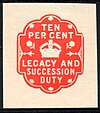Taxation in medieval England
| Taxation |
|---|
 |
| An aspect of fiscal policy |
Taxation in medieval England was the system of raising money for royal and governmental expenses. During the Anglo-Saxon period, the main forms of taxation were land taxes, although custom duties and fees to mint coins were also imposed. The most important tax of the late Anglo-Saxon period was the geld, a land tax first regularly collected in 1012 to pay for mercenaries. After the Norman Conquest of England in 1066, the geld continued to be collected until 1162, but it was eventually replaced with taxes on personal property and income.
Norman and Angevin England (1066–1216)[edit]
There was no formal division between the household of the king and the government in the Norman period, although gradually the household itself began to separate from the government. Thus, income from taxation merged with other income to fund the king and the government without any distinctions such as in the modern world.[9] Under the Norman and Angevin kings, the government had four main sources of income: (1) income from lands owned directly by the king, or his demesne lands, (2) income that derived from his rights as a feudal overlord, the feudal rights such as feudal aid or scutage (3) taxation, and (4) income from the fines and other profits of justice. By the time of King Henry I, most revenues were paid into the Exchequer, the English Treasury, and the first records of the Exchequer date from 1130, in the form of the first surviving Pipe Roll for that year.[10] From the reign of King Henry II, Pipe Rolls form a mostly continuous record of royal revenues and taxation.[11] However, not all revenue went into the Exchequer, and some occasional taxes and levies were never recorded in the Pipe Rolls.[10]
Taxation itself took a number of forms in this period. The main tax was the geld, still based on the land, and unique in Europe at the time as being the only land tax that was universal on all the king's subjects, not just his immediate feudal tenants and peasants. It was still assessed on the hide, and the usual rate was 2 shillings per hide. In certain circumstances, however, taxation was assessed in terms of services rendered to the crown, such as Avera and Inward.[12]
Because the geld was assessed on landowners, it only applied to free men who owned land, and thus serfs and slaves were exempt. Other exemptions were granted to favoured subjects or were a right that went with certain governmental offices.[13] The geld was unpopular, and because of the increasing number of exemptions, yielded smaller amounts. During the reign of King Stephen, it is unclear if the geld was collected at all, as no financial records survive. However, when King Henry II came to the throne, the geld was collected once more.[14] After 1162, however the geld was no longer collected.[13]
Instead, a new type of tax was imposed starting in 1166, although it was not an annual tax. This was the tax on moveable property and income, and it could be imposed at varying rates. Likewise, the Saladin tithe, imposed in 1188 to raise funds for a proposed crusade by King Henry II, was levied at the rate of 10% of all goods and revenues, with some exceptions for a knight's horse and armour and clerical vestments. Also excluded were those who had pledged to go on crusade with the king.[13]
In 1194, in part from need to raise the huge sums required for the ransom of King Richard I who was captive in Germany, a new land tax was instituted. This was the carucage, and like the geld it was based on the land. The carucage was imposed six times in all, but it produced smaller sums than other means of raising revenue and was last collected in 1224.[13] In 1194, as part of the attempts to raise Richard's ransom, a 25% levy on all personal property and income was imposed.[13] In other years, other rates were set, such as the thirteenth imposed in 1207.
Besides taxes on land and taxes on personal property, this period saw the introduction of taxes on trade. In 1202, King John imposed a custom duty of a fifteenth of the value of all goods imported or exported. It appears, however, that these duties were discontinued in 1206.[15]
Plantagenet England (1216–1360)[edit]
During the reign of King Henry III, the king and government sought consent from the nobles of England for taxes the government wished to impose. This led in 1254 to the start of the Parliament of England, when the nobles advised the king to summon knights from each shire to help advise and consent to a new tax. In the 1260s, men from the towns were included with the knights, forming the beginnings of the House of Commons of England.[15]
By the middle of the 13th century, the tax on moveable property had become fixed by convention at a fifteenth for those in the country, and a tenth for those living in towns. An innovation in 1334 was the replacement of the individual assessments by a lump sum assessment for each community.[15]
In 1275, King Edward I reestablished a customs duty, by setting a rate of a mark on each sack of wool (weighing 364 pounds (165 kg)) or 300 wool-fells, and a mark on a last of hides. Edward then added another tax, the maltolt, in 1294, on sacks of wool, which was in addition to the previous customs duty. These taxes were removed in 1296, but in 1303 they were reimposed but only on non-English merchants. Over the next 40 years, the maltolt was the subject of dispute between the king and Parliament, with the final result being that the tax was kept at a lower rate but that Parliament's consent was required to impose it.
